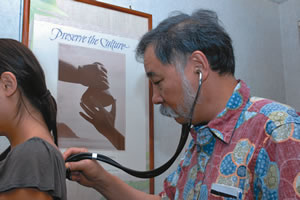Healthcare For Hawaiians
Interviewed by Melissa Moniz
Wednesday - July 22, 2009
E-mail this story | Print this page | Comments (0) | Archive
 Del.icio.us Share
Del.icio.us Share

Dr. Baron Ching
Medical director of Ke Ola Mamo Primary Care Clinic
Interviewed By Melissa Moniz
Where did you receive your schooling and training?
I went to Roosevelt High School. I got my B.S. in biology at the University of Oregon. I got my medical degree from John A. Burns School of Medicine; I did my residency in internal medicine there. I have been in private practice since 1983. About a year and a half ago I became medical director of the native Hawaiian health service, Ke Ola Mamo Primary Care Clinic. We do primary care here, mostly internal medicine.
Do you have an area of specialty or interest?
It’s always been general internal medicine, but I’ve done a lot of other stuff. Basically, I’ve always subscribed to the idea that we’re here to serve, so I ended up doing a lot of things to help out. I spent a lot of time in the psychiatric unit at Queen’s, and also I spent a lot of time at REHAB Hospital. I’ve done some internal medicine work there and I’ve seen some amazing things.
How does someone qualify to be a patient at Ke Ola Mamo?
The clinic is a creation of the 1988 Native Hawaiian Health Improvement Act. The clinic just came to be a couple of years ago. We will serve anybody, and patients don’t need to be Hawaiian; however, we only have funds for uninsured and under-insured native Hawaiians. We have subsidized labs and a subsidized medication program. So anyone can come here, but unfortunately we can’t use the federal funds for anyone but uninsured and under-insured native Hawaiians.
Within the Hawaiian population, what are the most common problems you see and treat?
The native Hawaiians have one of the lowest life expectancies and the highest infant mortality, very high instances of diabetes, heart disease, cancer. There are a lot of issues. They’ve always had a rocky relationship with the medical establishment and don’t really have a good trust. The other problem is that much of the medical establishment is not culturally attuned with them.

What are the reasons behind these statistics? Is it diet, genetics or other environmental factors?
Actually, there have been a lot of studies on minorities, but it seems to be more than just access to medical care, because a lot of them have good insurance and they should be knowledgeable. There’s something about the mindset. It seems that even with the access that they often won’t seek care. There’s a lot of distrust.
Does Ke Ola Mamo treat adults and children?
We plan to start treating children as well, but currently we only treat adults.
What are the goals for Ke Ola Mamo?
Our core responsibility is to improve native Hawaiian health. We haven’t had a lot of word go out, so we hope to have more patients come in with time. We anticipate, especially with these tough times, that we’ll start seeing more patients, and so we’re gearing up. Come 2010 we’re planning to open up another clinic in Kapolei. We are planning to still keep this clinic, since the bulk of the native Hawaiian population is in the city’s core.
As a member of the medical executive committee at REHAB Hospital, what are your responsibilities?
The medical executive committee is sort of like the board of directors for the medicine side. We’re here to provide the conscience of the organization and keep things on track. I’m also on the ethics committee and I’m chair of the bylaw committee.
E-mail this story | Print this page | Comments (0) | Archive
Most Recent Comment(s):













